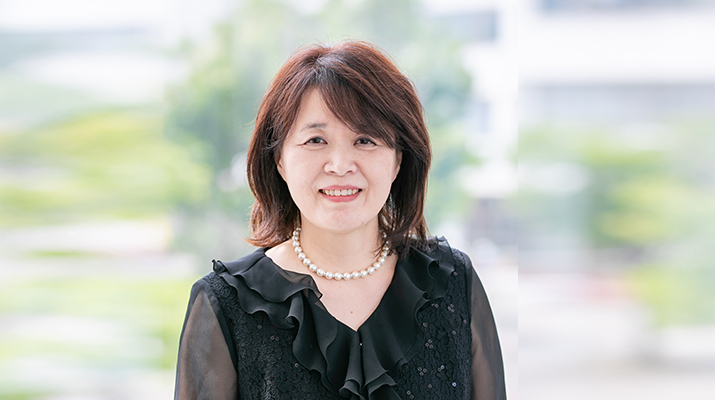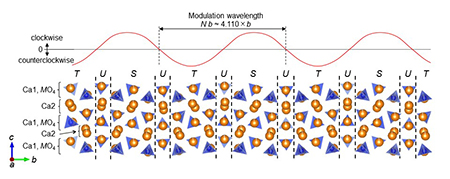
ここからコンテンツです。

Discovery of mechanism for improvement of photoluminescence intensity in phosphor material
Contributing material design for white LEDsBy Hiromi Nakano
A research team lead by Professor Hiromi Nakano of Toyohashi University of Technology, in collaboration with Nagoya Institute of Technology and the National Institute for Materials Science (NIMS), have clarified the mechanism by which the crystal structure of a red phosphor material obtained by adding P2O5 and Eu2O3 to a silicate (Ca2SiO4)-based material at various heat treatment temperatures changes in photoluminescence intensity due to differences in these factors. Phosphor materials are widely used in a range of everyday items from vehicles and projectors to LED lighting. Consequently, many researchers are working on developing brighter and more efficient phosphor materials. When designing brighter phosphor materials, a good understanding of photoluminescence intensity and crystal structure is required. In this study, the researchers succeeded in analyzing the changes in the crystal structure of the material at an atomic level due to heat treatment and the addition of P5+ and Eu3+ ions, and were able to clarify the relationships between these factors and the photoluminescence intensity.
White LEDs have undergone significant development over the past two decades, the market size has continued to expand, and LEDs are now the industry leader. Phosphor materials are used in a wide range of applications such as backlighting for monitors and automotive applications in addition to lighting. In the future, the competition to develop new materials in order to further diversify applications and realize advances in the areas of energy saving, cost-performance, high-color rendering, and long life, is likely to intensify. This area has already attracted a great deal of attention at academic conferences. Therefore, clarification of the characteristics and expression mechanism of phosphor materials is an important finding in the development of new materials. However, while most development of phosphor materials requires brighter and more efficient materials, there have not been many papers on the details of clarifying the mechanisms.
In this context, the research team synthesized a red phosphor made by adding P5+, and Eu3+ as an activator to Ca2SiO4 (silicate) while changing the heat treatment temperature from 1200 to 1500 degrees. This is because the crystal structure of silicate can easily be changed by heat. Here, the activator is an element (ion) that emits various emission colors from blue to red when added to the crystal.
As a result of the research, it was found that the photoluminescence intensity changes depending on the heat treatment temperature, and is closely related to changes in the crystal structure. The research teams noticed that the crystal structure of the phosphor material that had been heat treated at 1500 degrees changed to an incommensurate structure (IC), which is rare for ceramic materials. Normal crystal structures have a period that is an integer multiple, but the IC phase has a non-integer multiple of modulation. The photoluminescence intensity decreased due to the formation of the IC phase. By making full use of X-ray diffraction and computational science, the teams succeeded in analyzing the crystal structure in detail at the atomic level.

As a result of the analysis, the material has a modulation structure of 4.110 times in the b-direction, the structure has three types of SiO4 tetrahedron (T, U, S) gradients, and two more types of gradient (T", S") when looking at the long period. In this way, the teams discovered that the material constitutes an IC phase. It is thought that the reason for such a complex IC phase is that P is present in a part of the SiO4 tetrahedron, Eu is present in a part of the Ca, and the crystal structure is formed by rapid cooling treatment from a high temperature of 1500 degrees. Based on the precise analysis of the crystal structure, the researchers can answer questions such as: Which crystal sites should have an activator in order to synthesize a material with a brighter photoluminescence intensity? Which crystal structure is better? The teams believe that this knowledge can be used for new material design.
Prof. Hiromi Nakano and her team started research on phosphor materials using a silicate matrix doped with P2O5 about five years ago. Since the crystal structure of silicate can be controlled by the heat treatment temperature, she focused on the relationships between the crystal structure and the photoluminescence characteristics from the beginning of the research. In this research, when Prof. Hiromi Nakano, the team leader, showed the data to Professor Fukuda of the Nagoya Institute of Technology because the obtained XRD did not match the previous results, he advised that there was the possibility of an IC phase, and that the IC phase could also be analyzed by XRD. Prof. Nakano observed through electron diffraction that there was a crystal structure with a non-integer multiple period, but other means were needed to obtain quantitative data. The research collaboration between the group of XRD experts led by Professor Fukuda at Nagoya Institute of Technology and the IC phase analysis group led by Japan’s leading analyst for IC phase, Dr. Michiue at NIMS resulted in the successful precise analysis of the crystal structure.
This knowledge is important for the development of phosphor materials, and the researchers believe it will be of great use to industry in this field. Going forward, the researchers intend to conduct precise crystal structure analyses, further develop new materials, and widely disclose the new knowledge related to the physical properties of phosphor materials.
Reference
Hiromi Nakano, Shota Ando, Konatsu Kamimoto, Yuya Hiramatsu, Yuichi Michiue,
Naoto Hirosaki and Koichiro Fukuda, "Incommensurately Modulated Crystal Structure and
Photoluminescence Properties of Eu2O3- and P2O5-Doped Ca2SiO4 Phosphor", (2020) Materials, 13, 58. https://doi.org/10.3390/ma13010058
蛍光体材料の発光強度と結晶構造の関係が明らかに
白色LED用蛍光体材料開発の材料設計に貢献By 中野 裕美
中野裕美教授が率いる豊橋技術科学大学、名古屋工業大学、物質・材料機構の研究チームは、シリケート(Ca2SiO4)系材料にP2O5とEu2O3を添加した赤色蛍光体材料を、様々な熱処理温度で結晶構造を変化させ、その違いにより発光強度が変化するメカニズムを解明しました。蛍光体材料は、LED照明のほかにも、車載用、プロジェクター用など、身の回り品に多く使用されています。より明るく、効率のよい蛍光体材料を求めて、多くの研究者が多様な面から開発を進めています。より明るい蛍光体材料設計のためには、発光強度と結晶構造に関する知見が重要です。今回、熱処理とPイオンやEu添加により生じた、材料の結晶構造の変化を原子レベルで詳しく解析することに成功し、発光強度との関係を明確にすることができました。
蛍光体材料は、LED照明のほかにも、車載用、プロジェクター用など、身の回り品に多く使用されています。より明るく、効率のよい蛍光体材料を求めて、多くの研究者が多様な面から開発を進めています。より明るい蛍光体材料設計のためには、発光強度と結晶構造に関する知見が重要です。今回、熱処理とPイオンやEu添加により生じた、材料の結晶構造の変化を原子レベルで詳しく解析することに成功し、発光強度との関係を明確にすることができました。
白色LEDは、この20年間で著しい発展を遂げ、市場規模は拡大傾向が続き、今や産業界をリードする分野です。蛍光体材料の用途は広く、照明のほかにも液晶TV・モニター向けバックライト、車載用などがあります。今後、ますます用途が多様化し、さらに省エネ、低コスト、高演色、長寿命化実現のために、新材料開発には多くの研究者らによる競争が進み、学会でも注目度の高い分野です。そのため、新規蛍光体材料開発において、その特性と発現メカニズムの解明は重要な知見となります。しかし、多くの蛍光体材料の開発は、より明るく、高効率の材料を求める一方で、メカニズム解明の詳細に関する論文は多くないのが現状です。
そこで、研究チームは、Ca2SiO4(シリケート)にPと賦活剤としてのEu3+を添加した赤色蛍光体を、熱処理温度を1200度~1500度と変えて合成しました。なぜなら、シリケートは熱により容易に結晶構造を変化させるからです。ここで、賦活剤とは、結晶に入ることにより、青から赤色までいろいろな発光色を発する元素(イオン)のことです。
研究の結果、熱処理温度により発光強度は変化し、結晶構造変化と密接な関係があることが分かりました。注目したのは、1500度で熱処理をした蛍光体材料の結晶構造が、セラミックス材料にはめずらしい不整合構造(Incommensurate: IC)に変化したことです。通常の結晶構造は、整数倍の周期ですが、IC相は非整数倍の変調を有する結晶構造です。IC相の形成により発光強度は低下しました。そこで、X線回折法と計算科学を駆使することにより、原子レベルで結晶構造を詳しく解析することに成功しました。
解析の結果、b-方向に4.110倍の変調構造を有し、その構造はSiO4四面体の3種類(T,U,S)の傾きが存在すること、長い周期でみるとさらに2種類(T",S")の傾きの存在により、IC相を構成していることがわかりました。このような複雑なIC相が形成された理由は、SiO4四面体の一部にPが存在すること、Caの一部にEuが存在すること、さらに1500度の高温から急冷処理により形成されたと考えています。今回のような正確な結晶構造の解析により、より明るい発光強度を有する材料合成のためには、どの結晶サイトに賦活剤が入ればよいか?どういう結晶構造が好ましいのか?を知ることができ、新材料設計に今回の知見が活用できると思います。
シリケート母材にPを添加する蛍光体材料は、約5年前から研究を始めました。シリケートは熱処理温度で結晶構造を制御できるため、当初から結晶構造と発光特性の関係に着目していました。今回、チームリーダーの中野が、得られたXRDが今までの結果と一致しないため、名工大の福田教授にデータを見せたところ、IC相の可能性があり、XRDでもIC相を解析できるとアドバイスを受けました。非整数倍の周期をもつ結晶構造は、電子回折で中野が観察しておりましたが、定量的なデータを得るためには他の手段が必要でした。XRDの専門家である福田教授(名工大)のグループと、IC相の解析の第一人者である道上博士(NIMS)のグループの研究協力により、今回の精密な結晶構造解析の成功につながりました。
今回の知見は、蛍光体材料開発をする上で重要な知見であり、同分野の産業界でも役に立つと考えています。今後は、さらに新材料開発を進めながら正確な結晶構造解析を行い、物性と関連付けた新知見を広く公表していきたいと考えています。
Researcher Profile

| Name | Hiromi Nakano |
|---|---|
| Affiliation | Cooperative Research Facility Center |
| Title | Professor |
| Fields of Research | Inorganic materials, Structural analysis |
ここでコンテンツ終わりです。
